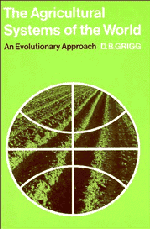2 - The early history of agriculture
Published online by Cambridge University Press: 10 March 2010
Summary
There are few subjects in which there have been such great changes in recent years as the prehistory of agriculture; and probably few in which there will be greater changes in the near future. Fortunately our only purpose here is to describe those features of the early history of agriculture which are relevant to an understanding of the development of modern types of agriculture.
Agriculture is generally understood to mean both the cultivation of crops and the rearing of livestock, and thus the beginnings of agriculture go back to the first domestication of plants and animals. It is helpful to make a distinction between ‘seed’ agriculture and ‘vegeculture’. The latter refers to plants reproduced by vegetative propagation, mainly tropical roots such as taro, manioc, yams, sweet potatoes and arrowroot. In tropical vegeculture rhizomes have to be cut from the growing plant and individually planted. There is less need to completely clear the natural vegetation; if a mixture of roots is grown, crops may be harvested, by digging up each root individually, over a long period, rather than at one specific time; there is thus less need for storage. Most tuber-growing communities also collected the fruits of trees such as bananas or coconuts, and little more than protection, rather than domestication, was necessary to provide a food supply.
In seed agriculture, which includes of course the cereals which are now the staple food crops in all but a few parts of the world, more initial clearance of vegetation is necessary, seed is sown en masse and harvested in one short period.
- Type
- Chapter
- Information
- The Agricultural Systems of the WorldAn Evolutionary Approach, pp. 9 - 23Publisher: Cambridge University PressPrint publication year: 1974
- 1
- Cited by

